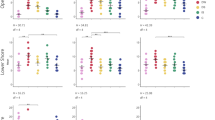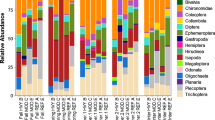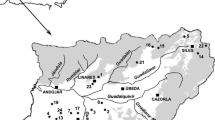Abstract
Few studies have examined zooplankton assemblages associated with grey willow (Salix cinerea) invasions in wetlands. Our aim was to quantitatively examine zooplankton composition among S. cinerea stands within the South Taupō Wetland, New Zealand, to determine whether these assemblages are affected by willow growth and willow control treatment using the herbicide metsulfuron (C14H15N5O6S). Alternatively, we examined whether wetland hydrology had an over-riding influence. Sampling was performed on three occasions (late-summer, mid-winter, and early-summer). Using Multidimensional Scaling and ANOSIM, we found no significant differences in zooplankton composition or environmental variables among native vegetation, live and dead S. cinerea sites, except for a difference in willow canopy density between late summer and winter. However, zooplankton composition differed on either side of a sand bar, suggesting areas separated by this barrier functioned independently. Overall, we found zooplankton communities to be regulated more by wetland hydrology than by willow presence. A limited willow effect was possibly due to the wetland being at an early stage of invasion, representing stand-alone individuals, with a continuous canopy not yet having formed. Alternatively, willows have lesser effects on invertebrates in wetlands than in streams. Ground control treatment of S. cinerea using metsulfuron had no apparent impact.



Similar content being viewed by others
References
Adair R, Sagliocco J, Bruzzes E (2006) Strategies for the biological control of invasive willows (Salix spp.) in Australia. Australian Journal of Entomology 45:259–267
Arar E, Collins G (1997) In Vitro determination of chlorophyll a Pheophytin a in marine and freshwater algae by Flurescence. U.S. Environmental Protection Agency (USEPA) method 445.0, revision 1.2, September 1997
Attayde JL, Bozelli RL (1998) Assessing the indicator properties of zooplankton assemblages to disturbance gradients by canonical correspondence analysis. Canadian Journal of Fisheries and Aquatic Sciences 55:1789–1797
Champion PD (1994) Extent of willow invasion - the threats. Proceedings of the wild willows in New Zealand. Proceedings of a willow control workshop hosted by Waikato conservancy, Hamilton, New Zealand. Department of Conservation. Pp 43-49
Chapman MA, Lewis MH (1976) An introduction to the freshwater Crustacea of New Zealand. William Collins, Auckland
Clarke KR, Gorley RN, Somerfield PJ, Warwick RM (2014) Change in marine communities: an approach to statistical analysis and interpretation, 3nd edn. PRIMER-E, Plymouth
Collier K (1994) Effects of willows on waterways and wetlands - an aquatic habitat perspective. Proceedings of the Wild Willows in New Zealand. Proceedings of a Willow Control Workshop hosted by Waikato Conservancy, 24–26 November 1993, Hamilton. Department of Conservation. pp 33–42
Cromarty P, Scott DA (eds) (1995) A directory of wetlands in New Zealand. Wellington, NZ, Department of Conservation
de Winton MD, Champion PD (1993) The vegetation of the lower Waikato Lakes, volume 1: factors affecting the vegetation of the lower Waikato lakes. NIWA Ecosystems Publication No. 7
Department of Conservation (2002) Tongariro/Taupo conservation management strategy 2002–2012. Wellington, Department of Conservation
Duggan IC (2001) The ecology of periphytic rotifers. Hydrobiologia 446:139–148
Duggan IC, Green JD, Shiel RJ (2002) Distribution of rotifer assemblages in North Island, New Zealand, lakes: relationships to environmental and historical factors. Freshwater Biology 47:195–206
Eivers RS, Duggan IC, Hamilton DP, Quinn JM (2018) Constructed treatment wetlands provide habitat for zooplankton communities in agricultural peat lake catchments. Wetlands 38:95–108
Eser PC (1998) Ecological patterns and processes of the South Taupo wetland, North Island, New Zealand, with special reference to nature conservation management. Unpublished thesis, Victoria University Wellington
Glova GJ, Sagar PM (1994) Comparison of fish and macroinvertebrate standing stocks in relation to riparian willows (Salix spp.) in three New Zealand streams. New Zealand Journal of Marine and Freshwater Research 28:255–266
Harding J, Clapcott J, Quinn J, Hayes J, Joy M, Storey R, Greig H, Hay J, James T, Beech M, Ozane R, Meredith A, Boothroyd I (2009) Stream habitat assessment protocols for wadeable rivers and streams of New Zealand. Christchurch, New Zealand, University of Canterbury. 136 p
Hornung JP, Foote AL (2006) Aquatic invertebrate responses to fish presence and vegetation complexity in Western boreal wetlands, with implications to waterbird productivity. Wetlands 26:1–12
Husted-Andersen D (2002) Control of the environmental weed Salix cinerea (grey willow) in the South Taupo wetland, central North Island, New Zealand. Unpublished thesis, The Royal Veterinary and Agriculutural University, Copenhagen, Denmark
Kratzer EB, Batzer DP (2007) Spatial and temporal variation in aquatic macroinvertebrates in the Okefenokee swamp, Georgia, USA. Wetlands 27:127–140
Lester PJ, Mitchell SF, Scott D (1994) Effects of riparian willow trees (Salix fragilis) on macroinvertebrates densities in two small Central Otago streams, New Zealand. New Zealand Journal of Marine and Freshwater Research 28:267–276
Lougheed VL, Chow-Fraser P (1998) Factors that regulate the zooplankton community structure of a turbid, hypereutrophic Great Lakes wetland. Canadian Journal of Fisheries and Aquatic Sciences 55:150–161
Lougheed VL, Chow-Fraser P (2002) Development and use of a zooplankton index of wetland quality in the Laurentian Great Lakes basin. Ecological Applications 12:474–486
Lucena-Moya P, Duggan IC (2011) Macrophyte architecture affects the abundance and diversity of littoral microfauna. Aquatic Ecology 45:279–287
McInerney PJ, Rees GN, Gawne B, Suter P, Watson G, Stoffels RJ (2016) Invasive willows drive instream community structure. Freshwater Biology 61:1379–1391
Medley KA, Havel JE (2007) Hydrology and local environmental factors influencing zooplankton communities in floodplain ponds. Wetlands 27:864–872
Ortega-Mayagoitia E, Armengol X, Rojo C (2000) Structure and dynamics of zooplankton in a semi-arid wetland, the National Park Las Tablas de Daimiel (Spain). Wetlands 20:629–638
Owen SJ (1998) Department of conservation strategic plan for managing invasive weeds. Wellington, New Zealand, Department of Conservation. 86 p
Partridge TR (1994) Ecological impacts of willows in wetlands. Proceedings of the wild willows in New Zealand. Proceedings of a willow control workshop hosted by Waikato conservancy, Hamilton, New Zealand. Department of Conservation. Pp. 17-22
Read MG, Barmuta LA (1999) Comparisons of benthic communities adjacent to riparian native eucalypt and introduced willow vegetation. Freshwater Biology 42:359–374
Rico-Martínez R, Arias-Almeida JC, Pérez-Legaspi IA, Alvarado-Flores J, Retes-Pruneda JL (2012) Adverse effects of herbicides on freshwater zooplankton. Herbicides - properties, synthesis and control of weeds. In: El-Ghany Hasaneen MNA (ed) herbicides—properties, synthesis and control of weeds, pp 405–434
Russell GH (1994) Values and threats of willows in waterways - an engineer's perspective. Proceedings of the wild willows in New Zealand. Proceedings of a willow control workshop hosted by Waikato conservancy, Hamilton, New Zealand. Department of Conservation. Pp. 23-27
Schoenberg SA (1988) Microcrustacean community structure and biomass in marsh and lake habitats of the Okefenokee swamp, seasonal dynamics and responses to resource manipulations. Holarctic Ecology 11:8–18
Serra MN, Albarinõ R, Villanueva VD (2013) Invasive Salix fragilis alters benthic invertebrate communities and litter decomposition in northern Patagonian stream. Hydrobiologia 701:173–188
Shiel RJ (1995) A guide to the identification of rotifers, cladocerans and copepods from Australian inland waters. Co-operative research Centre for freshwater ecology. Murray-Darling Freshwater Research Centre, Albury
Shiel RJ, Green JD (1996) Rotifera recorded from New Zealand, 1859-1995, with comments on zoogeography. New Zealand Journal of Zoology 23:191–207
Singers N (2009) An overview of habitat types and significant sites in Tongariro Taupo conservancy. Tongariro Taupo, Department of Conservation, 139 p
Suren A, Sorrell B (2010) Aquatic invertebrate communities of lowland wetlands in New Zealand; Characterising spatial, temporal and geographic distribution patterns. Wellington, Department of Conservation, 62 p
Thompson DG, MacDonald LM, Staznik B (1992) Persistence of Hexazinone and Metsulfuron-methyl in a mixed-wood/boreal Forest Lake. Journal of Agricultural and Food Chemistry 40:1444–1449
Thompson K, Reeves P (1994) History and ecology of willows in New Zealand. Proceedings of the wild willows in New Zealand. Proceedings of a willow control workshop hosted by Waikato conservancy, Hamilton, New Zealand. Department of Conservation. Pp 3-16
USEPA (United States Environmental Protection Agency) (1986) Pesticide fact sheet number 71: Metsulfuron-methyl. Office of Pesticide Programs, Washington, DC
Watts C, Rohan M, Thornburrow D (2012) Beetle community responses to grey willow (Salix cinerea) invasion within three New Zealand wetlands. New Zealand Journal of Zoology 39:209–227
Watts C, Ranson H, Thorpe S, Cave V, Clarkson B, Thornburrow D, Bartlam S, Bodmin K (2015) Invertebrate community turnover following control of an invasive weed. Arthropod-Plant Interactions 9:585–597
Webb CJ, Sykes WR, Garnock-Jones PJ (1988) Flora of New Zealand volume IV, naturalised Pteridophytes, gymnosperms, Dicotyledons. Botany Division, Department of Scientific and Industrial Research, Christchurch, N.Z. 1365 pp
Wech J, Suren A, Brady M, Kilroy C (2018) The effect of willow control using a glyphosate formulation on aquatic invertebrates within a New Zealand wetland. New Zealand Journal of Marine and Freshwater Research 52:16–41
Williams JA, West CJ (2000) Environmental weeds in Australia and New Zealand: issues and approaches to management. Austral Ecology 25:425–444
Acknowledgments
L. Laboyrie and W. Powrie assisted with field and laboratory work, and B. O’Brien with microscopy. Department of Conservation Turangi Office, particularly L. Roberts, assisted with the planning and execution of this research. B. Clarkson (Manaaki Whenua) provided comments that improved our manuscript. YT received financial support from the Genesis Energy Committee, a Tūwharetoa Māori Trust Board Scholarship, a Motukawa Farm Trust Education Grant, the Tumate Mahuta Memorial Scholarship, Te Runanga o Ngāi Te Rangi Iwi Trust Tertiary Education Grant, a Tauwhao Te Ngare Trust Tertiary Education Grant, a Poripori Farm A Trust Tertiary Education Grant, the Rose Hellaby Postgraduate Scholarship, the Golden Plover Wetland Research Award and a Tongariro Natural History Society Award.
Author information
Authors and Affiliations
Corresponding author
Additional information
Publisher’s Note
Springer Nature remains neutral with regard to jurisdictional claims in published maps and institutional affiliations.
Rights and permissions
About this article
Cite this article
Taura, Y.M., Duggan, I.C. The Relative Effects of Willow Invasion, Willow Control and Hydrology on Wetland Zooplankton Assemblages. Wetlands 40, 2585–2595 (2020). https://doi.org/10.1007/s13157-020-01359-5
Received:
Accepted:
Published:
Issue Date:
DOI: https://doi.org/10.1007/s13157-020-01359-5




